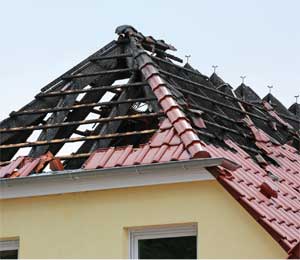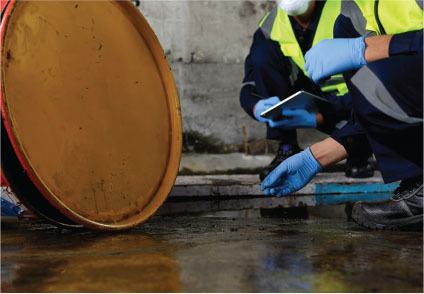September/October 2018
On Ethics: You Be the Judge
Arson Investigation Uncovers Ethical Dilemma

NSPE’s annual Milton F. Lunch Ethics Contest challenges members to consider the facts of a scenario and the questions it raises. This year’s winner, Amir Alansari, a PhD candidate at the University of North Carolina–Charlotte, received a $2,000 award.
Here’s his winning entry.
Facts
Engineer A is a professional engineer and a registered architect with extensive design and forensic engineering experience. In performing a forensic engineering investigation for an insurance company, Engineer A is asked to look at a beam that had been burned, as a result of arson in a residence that was at the time of the arson under construction. Following the initial arson investigation, Engineer A learns that the construction contractor determined that the beam could be reused on the project. Engineer A examines the 15-foot long beam and determines that the beam was slightly charred and was located next to a dining room with a 2-story ceiling. On the other side, the beam supported a second-floor bedroom, a wall, and (on both sides of the beam) a significant amount of roof of the residence. Engineer A initially observed that aside from the slight fire damage, the beam looked too light to provide adequate structural support. Engineer A measured the tributary area of roof, floor, and wall bearing on the beam and ran a series of structural calculations. Following his review, Engineer A determined that the beam was seriously under-designed. Engineer A observed that since the house was a tract home, there were other identical designs in the subdivision. Engineer A wrote his report and identified the design defect, and expressed his larger concern regarding the possibility that an inadequate structural member was used in other houses in the subdivision. Engineer A submitted his report to the insurance company that retained Engineer A. Engineer A, still concerned with his obligation to the public beyond just informing the insurance company, called the State Board of Professional Engineers, apprised them of the situation, and asked what more could and should Engineer A do about this situation. The Board’s response was that Engineer A had fulfilled his professional obligation by notifying the insurance company, in writing, of the defect.
Question
Did Engineer A fulfill his ethical obligations by providing the report to the insurance company that retained Engineer A under the NSPE Code of Ethics?
Discussion
The first fundamental canon of the Code of Ethics states that engineers shall hold paramount the safety, health, and welfare of the public. In almost all cases, the above canon overrules all other obligations. Engineers are required to take immediate action when they are presented with situations involving an impact on the public health and safety. However, the extent of their obligations is a matter of debate.
A case was reported in 2007 (BER Case No. 07-10) where an engineer (Engineer A) designed and built a barn on his property. After selling his property four years later, the new property owner made some modifications to the barn’s structure that was approved by the local authority. It was Engineer A’s belief that the new modifications compromised the structural integrity of the barn. Engineer A had verbally contacted the town supervisor who agreed to investigate the matter, but no action was taken. The question proposed in that case was whether Engineer A fulfilled his ethical obligations under the NSPE Code of Ethics.
In the case of BER Case No. 07-10, The Board of Ethical Review noted that the engineer had fulfilled his ethical obligations, however, the appropriate action would have been for Engineer A to have first notified, in writing, the current owner of his concerns regarding the structural integrity of the barn. The engineer should have made a written record of his communication with the owner and town supervisor and follow his verbal communication up with a written confirmation to the town supervisor. If appropriate actions were not taken within a reasonable time, Engineer A should inform the town supervisor that he would be obligated to contact county or state building officials, after a second written communication to the town supervisor.
A second relevant case (BER Case No. 90-5) occurred in 1990, where an engineer was hired by the owner to inspect an apartment building and provide expert testimony in support of the owner in a legal dispute with the tenants over repairs of defects in the building. The engineer discovered serious structural defects (unrelated to the repairs in question) which he believed presented a serious threat to the safety of the tenants. The owner’s attorney informed the engineer that he must keep his findings confidential as it was part of the lawsuit, whereby the engineer complied. The Board of Ethical Review ruled that it was unethical for the engineer not to report the information directly to the tenants and public authorities. The board stated that in cases where the public health and safety in endangered, engineers not only have the right but also the ethical responsibility to reveal such facts to the proper persons. Other relevant cases where the Board of Ethical Review made similar rulings include BER Cases Nos. 89-7, 92-6, and 00-5.
In the present case, Engineer A did in fact fulfill his ethical obligations of the Code of Ethics for Engineer Section II.3.a. by providing the report to the insurance company that retained him. However, the question of whether he fulfilled all his ethical obligations remains. As noted in BER Case No. 07-10, the appropriate action was for the engineer to have also contacted the owner of the property. More importantly, it is Engineer A’s ethical obligation to inform the occupants of the buildings since they may be directly in danger. The person at the state board may have assumed that the since the engineer notified his client of the issues, all of Engineer’s A obligations were fulfilled and the responsibility was now with the insurance company. However, the insurance company may choose to withhold the information or may not act appropriately; therefore, in accordance to Section II.1.a of the Code of Ethics for Engineers, Engineer A must take responsibility of notifying all the involved parties.
Conclusions
The engineer fulfilled his ethical obligations with regards to notifying the insurance company of his findings. However, Engineer A did not fulfill all his obligation and the appropriate action would have been to notify the tenants and property owners of his concerns with the structural integrity of the building.
NSPE Code References
Section II.1.: Engineers shall hold paramount the safety, health, and welfare of the public.
Section II.1.a.: If engineer’s judgment is overruled under circumstances that endanger life or property, they shall notify their employer or client and such other authority as may be appropriate.
Section II.1.f.: Engineers having knowledge of any alleged violation of this Code shall report thereon to appropriate professional bodies and, when relevant, also to public authorities, and cooperate with the proper authorities in furnishing such information or assistance as may be required.
Section II.3.a.: Engineers shall be objective and truthful in professional reports, statements, or testimony. They shall include all relevant and pertinent information in such reports, statements, or testimony, which should bear the data indicating when it was current.


 Volunteering at NSPE is a great opportunity to grow your professional network and connect with other leaders in the field.
Volunteering at NSPE is a great opportunity to grow your professional network and connect with other leaders in the field. The National Society of Professional Engineers (NSPE) encourages you to explore the resources to cast your vote on election day:
The National Society of Professional Engineers (NSPE) encourages you to explore the resources to cast your vote on election day:


